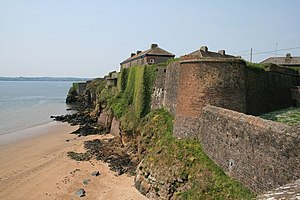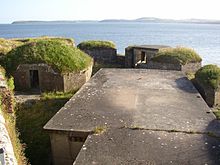Duncannon Fort
| Duncannon Fort | ||
|---|---|---|
|
Duncannon Fort |
||
| Alternative name (s): | Dún Canann | |
| Creation time : | 1587-1588 | |
| Castle type : | Away | |
| Conservation status: | restored | |
| Standing position : | English royal family | |
| Construction: | Old-red sandstone | |
| Place: | Duncannon ( Waterford ) | |
| Geographical location | 52 ° 13 '15.4 " N , 6 ° 56' 11.6" W | |
| Height: | 4 m ASLTemplate: height / unknown reference | |
|
|
||
Duncannon Fort ( Irish Dun Canann ) is a star fort in Duncannon on a peninsula in the eastern part of the port of Waterford in Ireland's County Wexford . From there, the Three Sisters , the River Barrow , the River Nore and the River Suir can be reached. Duncannon Fort is considered a National Monument .
history
The Normans built a fort on this site as early as the 12th century ; it is an even earlier fort earthworks of the Gaels have been there. Today's star fort was built by Queen Elizabeth I in the years 1587–1588 to defend Waterford against a feared invasion of the Spanish Armada .
Duncannon Fort was involved in fighting during the Irish Confederation Wars. Under the royalist commander Laurence Esmonde, 1st Baron Esmonde , it was besieged and finally captured by Irish Confederates under the command of Thomas Preston, 1st Viscount Tara , from January to March 1645. Mortars were used for the first time in Ireland . Oliver Cromwell failed to retake Duncannon Fort in 1649, but the royalists abandoned it in 1650 after a blockade by Henry Ireton .
In 1690 two kings were guests at the fort: King James II of England and James VII of Scotland sailed from Duncannon to Kinsale and then on to France on July 3rd ; King Wilhelm III. stayed there in September when bad weather delayed his return to England. The place where King Jacob's ship left is called “King James' Hole”.
A lighthouse was built in 1774; it is still in use today.
The fortress at Duncannon, under the command of William Fawcett, was one of the few places in County Wexford not taken by the United Irishmen during the 1798 Rebellion . Fort and town became a retreat for fleeing loyalists and troops in the south of County Wexford, which also served as a prison and place of execution for rebels. This made them notorious as the place of execution for "Croppy Boy", who is mentioned in the song "The Croppy Boy".
Duncannon Fort continued to serve as a fortress for the British Army and was turned over to the Irish National Army in 1922 , only to burn down in the Irish Civil War that same year . The Army Reserve Ireland (FCÁ) occasionally used it as a summer camp, and in 1993 it was handed over to the Wexford County Administration, which later opened it as a museum.
description
Duncannon Fort is a star fort. Cannons were installed along its flanks, pointing upstream and downstream. On the west side there were batteries that could coat the entire inlet.
The landside defenses consisted of a simple bastion that protruded from the center of the facade, a deep moat and a medieval wall. Primitive capons protruded into the trench, and each of the contrescarpegalleries had a saddle gate so that the garrison could enter the trench without being seen.
A nearby hill, Windmill Hill , would have been a perfect place to bombard the fort. The English recognized this and raised the eastern wall in 1606 to prevent this.
Individual evidence
- ↑ Duncannon Fort . In: Fortified Places . Archived from the original on October 25, 2016. Retrieved June 19, 2019.
- ↑ Anna Leigh Margey: The 1641 Depositions and the Irish Rebellion . Routledge. S. 144. October 6, 2015. Accessed June 19, 2019.
- ↑ Billy Colfer: The Hook Peninsula: County Wexford . Cork University Press. P. 107. January 1, 2004. Accessed June 19, 2019.
- ↑ a b Duncannon Fort . In: DoChara - Inside Guide to Ireland . November 28, 2008. Retrieved June 19, 2019.
- ^ Brendan Keane: Conservation plan for Duncannon Fort . In: Wexford Echo . September 16, 2015. Archived from the original on November 16, 2017. Retrieved June 19, 2019.
- ↑ The Croppy Boy . In: Music in the Works of James Joyce . Retrieved June 19, 2019.
- ^ A Prospect of the Fort of Duncannon . In: Online Gallery . British Library. Retrieved June 19, 2019.


